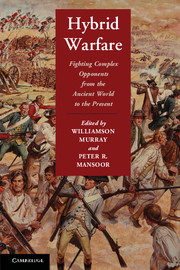Book contents
- Frontmatter
- Contents
- Figures
- Contributors
- Acknowledgment
- 1 Introduction
- 2 Conquering Germania
- 3 Keeping the Irish Down and the Spanish Out
- 4 The American Revolution
- 5 That Accursed Spanish War
- 6 The Union's Counterguerrilla War, 1861–1865
- 7 Fighting “this nation of liars to the very end”
- 8 Small Wars and Great Games
- 9 An Unexpected Encounter with Hybrid Warfare
- 10 Hybrid War in Vietnam
- 11 Conclusion
- Index
- References
9 - An Unexpected Encounter with Hybrid Warfare
The Japanese Experience in North China, 1937–1945
Published online by Cambridge University Press: 05 August 2012
- Frontmatter
- Contents
- Figures
- Contributors
- Acknowledgment
- 1 Introduction
- 2 Conquering Germania
- 3 Keeping the Irish Down and the Spanish Out
- 4 The American Revolution
- 5 That Accursed Spanish War
- 6 The Union's Counterguerrilla War, 1861–1865
- 7 Fighting “this nation of liars to the very end”
- 8 Small Wars and Great Games
- 9 An Unexpected Encounter with Hybrid Warfare
- 10 Hybrid War in Vietnam
- 11 Conclusion
- Index
- References
Summary
On 7 July 1937, the Second Sino-Japanese War broke out at Lukouchou (the Marco Polo Bridge) with a skirmish between troops of the Chinese Nationalist XXIX Corps and the Japanese Tientsin garrison. Despite the Japanese government's policy of not expanding the conflict, a policy supported by the Imperial Army's general staff, the conflict grew into an all-out war between the two nations. Instead of declaring war, the Japanese government termed the conflict the “North China Incident,” which it renamed the “China Incident” two months later as the war in the north quickly expanded to central and south China. The Japanese Army in China, consisting of two infantry brigades with some 5,600 troops in July 1937, expanded to 24 divisions with nearly 800,000 soldiers by 1939.
The eight-year-long Sino-Japanese military conflict, which finally led Japan into the Second World War, was unanticipated by its military establishment in two major respects. First, the strategic concerns of the Japanese Army were primarily a potential confrontation with the Soviets along the northern border with Manchukuo and a possible involvement in a naval war with the United States in the western Pacific. As a potential opponent, China had long been rated secondary to the Soviets and the Americans according to Japanese defense plans. The name “China Incident” underlines the reluctance of the Japanese government to wage a formal war with China. Second, how the Imperial Japanese Army fought the Second Sino-Japanese War was quite different from the type of conflict it had initially expected and prepared to fight. It was a limited, protracted war against both regular and irregular forces that was quite different from the expected short, decisive conflict. This was particularly true in the case of the Japanese military experience in north China.
Keywords
- Type
- Chapter
- Information
- Hybrid WarfareFighting Complex Opponents from the Ancient World to the Present, pp. 225 - 253Publisher: Cambridge University PressPrint publication year: 2012
References
- 1
- Cited by



